Filter for a washing machine: overview of types, selection criteria + installation features
Manufacturers of washing machines produce sophisticated electronic devices with many features that make life easier for their owners. They can do everything - do high-quality washing, steam laundry and dry clothes. However, “smart” units remain defenseless against hard and rusty piped water.
How to prevent damage to the home helper? This question is asked by many owners and potential buyers of washing machines. One of the effective methods is to mount a filter for the washing machine, which protects the working components of the equipment from premature damage.
We will figure out what types of filter elements exist, what are the features of their selection, installation, use and maintenance. The information provided will help organize comprehensive protection of the washing machine and extend the life of expensive equipment.
The content of the article:
The effect of untreated water on the details of the washer
Rumor has it that the washer can function without interruption for many years without any filters. However, in modern realities this is far from the case. The reason for this is various impurities that pollute the water. What can they be?
Mechanical impurities (dirt, sand, small debris), if not cleaned, the internal cleaner can substantially clog over time. The pressure that is necessary to start the water will gradually drop, which can cause a pump breakdown, and the device will stop collecting water.
Rust detrimental to the result of washing, because things fade, acquire new stains or do not wash off at all.
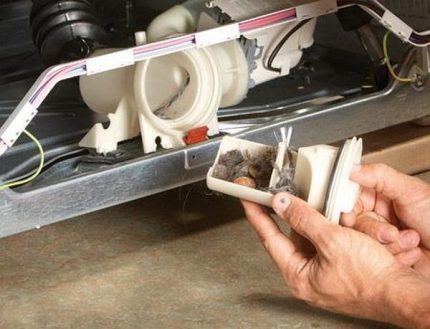
Hard water poses no less danger.When heated, mineral deposits from the water settle on the heater and the walls of the apparatus in the form of impenetrable scale. And this can provoke an increase in energy consumption for heating water to the required temperature.
It is necessary to remove scale in a timely manner, otherwise a more serious breakdown is possible, requiring expensive repairs. To service the washer periodically use decalcifier.
In addition, hard water provokes the appearance of corrosion - it is it that is the key reason for the rapid wear of important parts and reduce the life of the machine.
Also, untreated water often becomes a decisive factor in machine depressurization due to a decrease in the elasticity of rubber seals.
Situations indicating that a clogged filter needs to be cleaned:
- after washing or rinsing, the process of draining water is unrealistically slow;
- the machine completes the wash cycle and does not continue it even after the processor is restarted;
- a breakdown code flashes on the monitor, the direct cause of which may be raw water;
- spin does not start or rinse modes.
If such malfunctions in the operation of the washing machine happen often, then it is worth considering the quality of water filtration.
Procedure for cleaning the drain and inlet filter
Initially, all washing machines for their productive and safe operation by the manufacturer already have two factory filters:
- jellied (or inlet) - installed immediately after the inlet pipe;
- drain (or outlet), which removes water after washing / rinsing.
We will understand the design and maintenance features of each filter.
Overview of the filler and its service
The inlet filter is mounted at the junction of the inlet hose with the machine. And at the very bottom of the device there is a drain filter, in various models it is located either on the left or on the right and is covered with a special rectangular cover.
Its main function is to detain large and medium debris, which can cause a malfunction or breakdown of the machine.
The instructions for the washing machine say that to clean the filters you must call a specialist. But if the user is on the “you” with the tools, then he will be able to independently perform these simple actions.
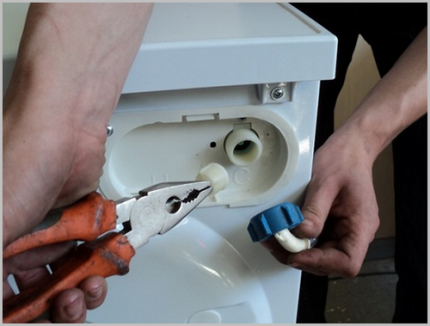
First you need to disconnect the device from the network, shut off the water and free access to the back of the device. Be sure to place a piece of a dense rag under the washer floor so that water does not flow in there, and carefully unscrew the water inlet hose.
Then carefully remove the cleaner (it looks like a thimble) using tweezers or pliers. It is necessary to wash the metal mesh of the filter under a stream of warm water, using a toothbrush to remove dirt.
Wipe with a cloth afterwards (do not use a very long pile cloth). After that, install the part in place and screw the hose.
Procedure for cleaning the drain type of filter
A variety of brands of washing devices are slightly different from each other in design, drain cleaners also vary.
AT washing machines IndesitFor example, the drain filter is cleaned in this way:
- gently open the panel located on the left or right bottom of the device;
- remove the inside by unscrewing the plug counterclockwise;
- After removing dirt and debris, screw the element tightly clockwise until it stops.
During filter cleaning cars Samsung Be sure to pay attention to the location of the screw handle.
In some models, for tight sealing, it must lock in the correct position. If this is not done, then the water during the washing set will flow out of the drain cleaner.

You can avoid contamination of the drain filter if you follow simple rules for its operation. Rinse the part regularly so that dirt does not accumulate.
If you wash a couple of times a day or 1 time in 2 days, then it is enough to carry out only 1 cleaning in 3 months. In addition, pockets and other indentations in dirty laundry should be carefully checked to prevent dirt, hair and small parts from getting into the drum.
Try to use only proven detergents. And it is better to test new ones with a hand wash, as large particles of powder can only partially dissolve in water and clog the cleaner, especially if the program involves the use of cold water.
Types of cleaning devices
To protect parts of the electrical device from mechanical particles and chemical contaminants, users install special water purifiers for the washing machine.
Line Filters. Such devices are installed on a common water supply pipe. The functionality of the main device is similar to a filler cleaner.
It is mounted on the inlet pipe to clean the incoming water from rust, sand and large particles. Please note that this type of filter does not affect the chemical and biological composition of water.
For mounting the main filter, it is necessary to make a separate insert in the pipe. The general cleaner is mounted immediately after the meter and in front of the inlet hose.
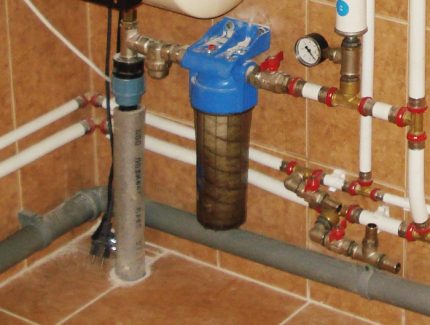
Coarse filter performs functions similar to the main one, and at the same time it is necessarily mounted in front of the washing machine.
Please note that the filters clog quite quickly. Therefore, it is necessary to regularly clean them and replace replaceable cartridges so that the washing machine lasts as long as possible.
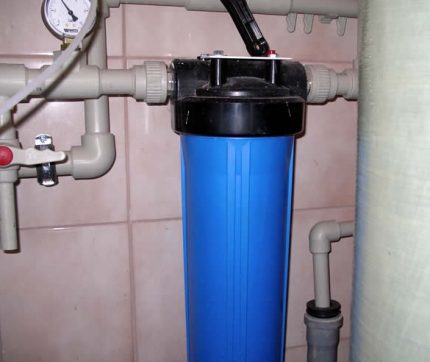
The user can supply a coarse filter for a machine without the help of specialists. You do not need to use any sophisticated tools. It is enough to take a wrench and screw the filter to the machine. The flask is mounted in front of the inlet hose.
To install, do the following:
- Block the water.
- Unscrew the inlet hose from the pipe to which it is attached.
- Install the water filter cleaner in its place.
- Then screw the hose itself.
The purifier uses standard thread suitable for pipes at three quarters of an inch. Exactly the same thread is in the hose of the washing machine.
The quality of water treatment will directly depend on kind of filter and how heavily polluted the tap water coming through the pipes.
To purify water at a biological level, softener filters are used:
- polyphosphate;
- magnetic.
Devices of this kind remove the notorious stiffness from water, especially calcium carbonate salts. Their action is based on chemical or magnetic cleaning methods. Please note that after such filtering, process water will flow through the pipes and cannot be used for drinking.
Features of additional filters
We outline the features of various devices for water purification, describe their operation principle, installation specifics, and also find out the effectiveness of the application.
# 1 - polyphosphate cleaning device
A polyphosphate filter is a flask with large, transparent grains similar to salt. It directly affects the biochemical composition of water. Water after cleaning with this filter becomes technical.
The principle of operation is based on the slow passage of fluid through sodium polyphosphate. When its active element reacts with water, it binds carbonates (the base of hardness salts) and closes its path to the heating element and other parts of the washing machine.
Such filters are connected to a pipe with cold water, since at temperatures above +50 ° C the salt itself begins to break down, and in this case there will be no effect from this filter.
From time to time, it will be necessary to add polyphosphate to the filter flask, as its components dissolve.
Manufacturers recommend changing the filter-filler if the flask content has decreased by 50% or the container content has not changed for a long time. As practice shows, crystals retain their cleansing functions for six months.
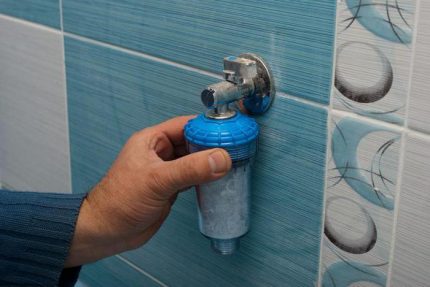
The polyphosphate filler itself can be produced in various forms. Most often it can be seen in the form of translucent granules. Less popular is the powder version, which is produced in the form of pressed white tablets.
Experts recommend using the first option for washers, as it dissolves more efficiently and faster, covering a large area. Sometimes sodium polyphosphate hides under the name "Graham salts."
Subtleties of installing a filter flask
A polyphosphate cleaner is installed in the same way as a deep filter. It should be mounted in front of the machine. Installation and replacement of the active substance of the filter can be dealt with without the help of a specialist.
# 2 - water deferrization filter
The presence of iron does not affect the operation of the washing machine in any way, since the process of iron deferrization occurs at the city's water pressure stations. But what if you live outside the city or in the country?
To get started, do an experiment. Put clean water in a glass jar. Put in a bright place for about 3 days. If, after this period, the wall is covered with yellow plaque (like rust) and the water has turned a shade of the same color, then iron removal should be carried out.
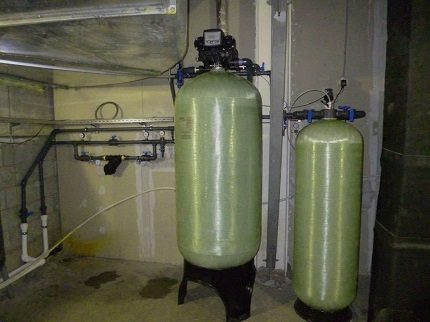
In this situation, a special filter is needed - a rather bulky device filled with "green sand". In simple words, the principle of its action is the "transition" of ferrous iron to ferric.
Purpose of installation of a cleaner
Only a specialist should install a deferrization filter. Before installation, a water analysis is required. To install this device, you need to allocate a special place.
# 3 - magnetic type cleaner
The principle of operation of a magnetic filter is based on the influence of a magnetic field on the structure of water in the pipe through which it flows.
In simple words, the cleanser dissolves calcite. It is he who makes the water more rigid and, accordingly, provokes the formation of scale during heating of the heating element.
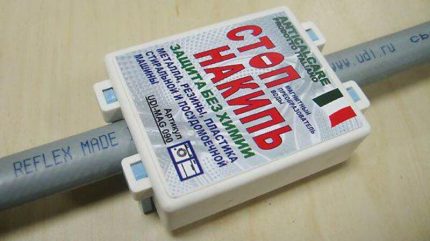
In a natural state, calcite particles adhere to each other, thereby creating chains, therefore, a precipitate of substance forms on the machine parts.
The magnetic field breaks these bonds and therefore the water purified by such a filter is really softer. And the scum that has already stuck to the walls of the machine breaks up and its particles falling into the water lose their ability to re-settle on the surface.
That is why treated water has the property of freeing the walls of the washing machine from other various precipitations. Washing in such water will require less detergent, and the filter itself does not need to be cleaned.
Nuances of mounting magnetic filters
Some models of magnetic cleaners consist of 2 elements that are mounted directly on top of the pipe through which water is supplied to the machine. Both parts of the magnetic filter are fastened together with screws.
What to look for when choosing?
If the water in the tap with visible impurities precipitating, it is advisable to install a common main cleaner.
When this is not possible, the filter should be installed directly in front of the washing machine.
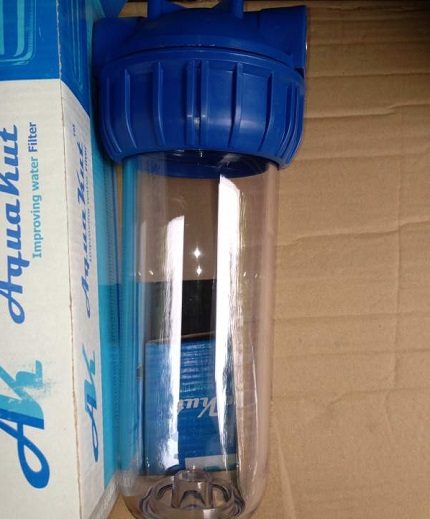
If in doubt, do you need a softening filter for water, then order a laboratory test. It will show the chemical composition and level of hardness. Based on this data, decide which cleaner to purchase.
To find out the hardness of water at home, you need to conduct an elementary experiment. To do this, lather your hands or a small rag with laundry soap (72%) and rub them.
If lush foam is formed, then the water is soft and the filter is not needed, otherwise you should consider installing a softener.
Conclusions and useful video on the topic
If you intend to independently clean or install filters, it is better to analyze the experience of other users in advance by watching small, but informative videos.
Video help for those who want to clean the filter in the car on their own:
Detailed consultation on the selection and proper installation of the main cleaner for washing:
What is the main privilege of a polyphosphate filter to soften water, how does it work? You will find answers to all questions in the video consultation:
The choice of degree of protection, of course, is yours. However, experts believe that Two filters will provide complete protection for the washing machine: one for cleaning from dirt, sand, rust, and the second for softening the water. Such a tandem will extend the century of expensive equipment and save owners time and money.
And which filter to protect the washing machine did you choose? Or maybe you refused to use an additional treatment device? We look forward to your comments, questions and advice on the selection and installation of the filtering device - the contact form is located below.

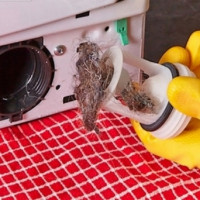 How to clean a filter in a washing machine: an overview of best practices
How to clean a filter in a washing machine: an overview of best practices  Built-in washing machines: selection criteria + TOP-10 of the best models
Built-in washing machines: selection criteria + TOP-10 of the best models 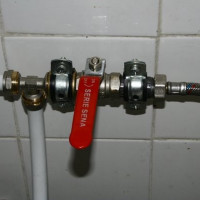 The crane for the washing machine: a review of the structures + installation instructions
The crane for the washing machine: a review of the structures + installation instructions  Narrow washing machines: selection criteria + TOP-12 of the best models on the market
Narrow washing machines: selection criteria + TOP-12 of the best models on the market 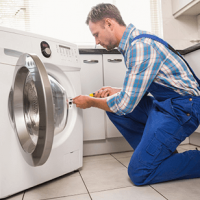 Do-it-yourself washing machine repair: an overview of possible breakdowns and how to fix them
Do-it-yourself washing machine repair: an overview of possible breakdowns and how to fix them 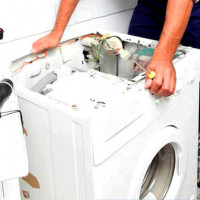 Do-it-yourself Indesit washing machine repair: an overview of common problems and how to fix them
Do-it-yourself Indesit washing machine repair: an overview of common problems and how to fix them  How much does it cost to connect gas to a private house: the price of organizing gas supply
How much does it cost to connect gas to a private house: the price of organizing gas supply  The best washing machines with dryer: model rating and customer tips
The best washing machines with dryer: model rating and customer tips  What is the color temperature of light and the nuances of choosing the temperature of the lamps to suit your needs
What is the color temperature of light and the nuances of choosing the temperature of the lamps to suit your needs  Replacement of a geyser in an apartment: replacement paperwork + basic norms and requirements
Replacement of a geyser in an apartment: replacement paperwork + basic norms and requirements
Tell me, is it necessary to install a filter before the washer if the water in the water supply is not hard and clean enough according to the analysis results? In our city there are no problems with water hardness, and the house is new, all the pipes, too. And then I heard a lot of horror stories that without a filter it will not work for six months. Now I think: maybe this is in old houses, where are the communications of pre-war production?
Well, if you have test results and water of normal hardness, Natalya, and according to GOST it meets the standards for drinking water, then you can do without filters. Filters are needed if water with impurities is deposited on the heater, drum and other important parts of the washing machine under the influence of high temperature. But in general, I recommend everyone to put filters, you can find quite cheap, a possible repair of the washing machine will cost much more.
In fact, many people are surprised that in some cities there is really enough clean water from the water supply, which does not have any impurities. In our city, too, especially in the part where I live, there is not hard water, which, in principle, can even be drunk. But still I put a filter in front of the washer, now I will explain why.
Of course, the water in the system may not be rigid and meet the necessary requirements. But the condition of our plumbing systems leaves much to be desired. That's why a filter is needed, because due to deposits on the water pipes that can get into the washing machine, the likelihood of breakage increases.
And yet, for the future, suddenly you decide to clear the machine of scale, I do not recommend using chemistry, and even more so using folk methods. Remove the ten and clean it by hand. Regarding the filter, I can recommend the FW 5 anti-scale filter, it costs 3-4 dollars.
Tell me where you can buy a filler (inlet) filter for the LG washing machine ??? I have the same as in the picture with pliers. Was ...